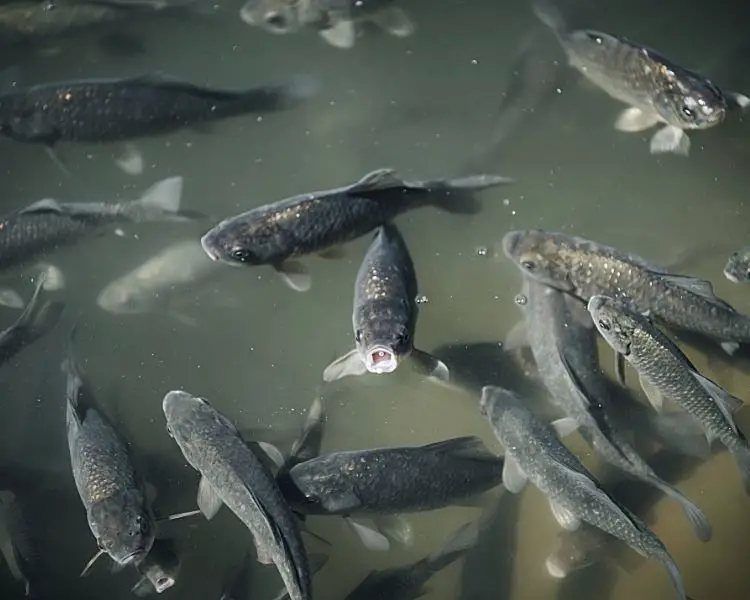Black carp originally came to America in the 1970s and have been found in the lower Mississippi River and Red River in Louisiana since the 1990s. Although they naturally occur in lakes, rivers, and channels, you might be wondering if black carp can also live in ponds? To answer this question, we consulted with the fish experts, and this is what they said.
The black carp can live in ponds and has been used to control the disease-carrying snail population in commercial fishponds since the 1970s. Today, black carp is still used in this way, although it has since been discovered that this fish can cause a decrease in healthy mollusk populations.
Although black carps are not native to America, they have been used for commercial farming in American fishponds for many years. Their role is to reduce the number of disease-carrying pond snails in catfish and other fishponds. Unfortunately, although they are great at their job, they can also potentially cause problems. This article discusses the perfect pond environment for black carp and how to care for them.
How To Grow Black Carp In Ponds

Although black carp naturally occurs in channels, lakes, and rivers, they can be grown in ponds. In this case, black carp isn't cultivated alone but is kept in a pond with other fish species, such as bass and catfish.
To start a commercial fishpond with black carp, here are certain steps you must follow:
1. Pond Size For Growing Black Carp
When growing black carp, you must consider the space they require to grow successfully. The recommended pond size for black carp is about one hectare for every four black carp. While this might sound like a massive pond, it has sufficient space for 30,000 to 40,000 fish.
The pond must be big enough to allow the fish to move around without feeling overcrowded. A black carp pond requires the addition of lime and inorganic and organic fertilizers. Black carp do best in slightly salty water, with a pH level between 7.5 and 8.5. Black carp can tolerate water oxygen levels as low as 2mg/L.
2. Stocking Black Carp In Ponds
You can purchase your black carp seeds from another fish farmer when your ponds are ready. However, you cannot transport black carp from one state to another, according to FWS (Fish and Wildlife Services) regulations. Therefore, you must purchase black carp seeds from a farmer in your state.
The seeds must be placed in a nursery tank. Once the fingerlings hatch, they must be kept in the nursery tank for about a month or until they are about five inches long. Once the black carp fingerlings reach the appropriate size, they can be transferred to the farming pond.
3. Feeding Black Carp In Ponds
Black carp are primarily used to reduce snail populations in ponds. Adult and older juvenile black carp are bottom feeders. They eat mollusks, such as snails, muscles, and other benthic invertebrates. In addition, small fingerlings and young juvenile black carp feed on zooplankton and aquatic insects. Therefore, maintaining proper pH levels is crucial to ensure the black carp has a sufficient food supply.
4. Life Expectancy Of Black Carp In Ponds
With the proper water pH levels and sufficient food, black carp should reach sexual maturity between the age of six and eleven. However, in many cases, the black carps are sterile to prevent their population from spreading if they accidentally escape into the wild.
Black carp can live up to fifteen years. The non-sterile black carp start breeding at about six years old and in water temperatures between 79 and 30°F. Female black carp can produce one million eggs in a single spawn
Now that we have discussed how to grow black carp in a pond and their life expectancy and eating habits, we can discuss why many bass and catfish farmers keep black carp in their ponds and the potential risks of having black carp.
Why Are Black Carps Kept In Ponds?
Black carp were initially brought to America to help reduce the snail population found in fishponds. The snail population is a concern because of two parasites, known as yellow grub and Bolbophorus confusus. Aquatic snails are the hosts of these parasites, and from them, they migrate to the fish, making it inedible. Fish can also die due to these parasites.
Because black carp eat mollusks, including snails, they were bought to control the snail populations in these ponds. Fortunately, this approach worked, and many fish farmers still use black carp today as a biological snail treatment.
Therefore, in America, black carp are exclusively used in ponds and are rarely found in rivers, streams, or lakes. Black carp aren't farmed for food purposes in America, and even though you can eat black carp, it is said to taste like mud and are full of bones. Never eat raw carp as they can contain traces of the parasites inside the mollusks they eat.
Although black carp are extremely useful in controlling the spread of parasites in commercial fish farms, their population is strictly monitored. Many environmentalists and fish farmers are concerned about the effects of black carp on the environment. Why is that, you might ask?
Why Are Black Carp A Threat To The Environment?
Even though black carp are a massive help in the commercial fishing industry, they are considered not only threatening to the environment but are listed as an "injurious" species by the U.S. Fish and Wildlife Service (FWS). In addition, because black carp is not native to America, it can have detrimental effects on the environment if released into the wild.
The biggest concern for conservationists is the eating habits of black carp. A single black carp can eat as much as 4 pounds of mollusks per day. As many native muscles in America are endangered, it is a genuine concern that black carp can cause extreme environmental damage if they are accidentally released into the wild.
Therefore, at times people were only allowed to have sterile black carp. The carp seeds go through a process that makes the fingerlings and adult black carp sterile. This prevents them from reproducing if they ever make it to rivers or lakes.
Therefore, although the black carp have immeasurable value for fish farmers, they are still considered a threat to the natural environment. Therefore, many precautions are in place to prevent them from becoming overpopulated.
Conclusion
Black carp can live in ponds and are often used to control the snail population in commercial fishponds. Black carps eat these snails and other mollusks and help reduce the chances of parasites spreading among the other cultivated fish. The FWS has listed black carp as an invasive species, as they pose a significant threat to endangered mollusks found in the U.S.
